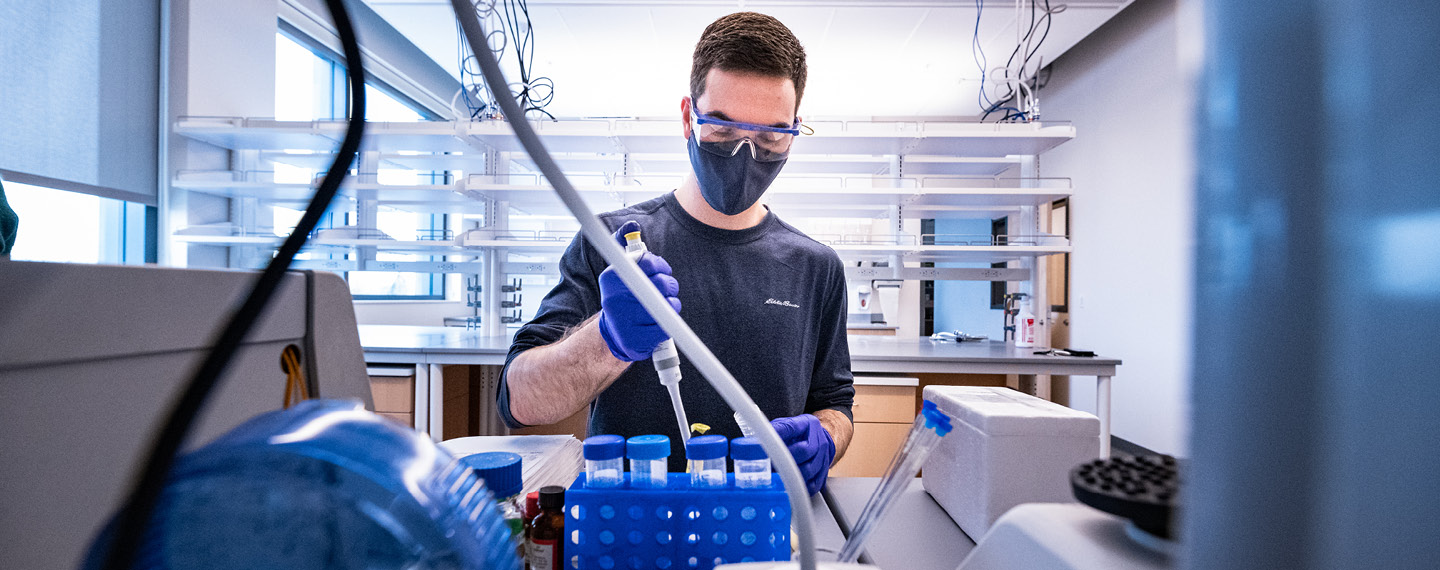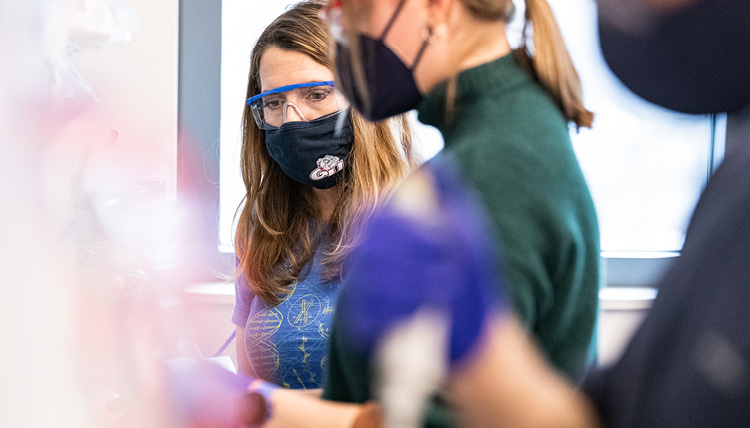Hard to Stem Enthusiasm of Faculty, Students for New Bollier Center

In December and over the Christmas break, faculty in the process of moving into their new spaces in a building they helped design – the John and Joan Bollier Family Center for Integrated Science and Engineering – began singing its praises. Students, too, were thrilled by what they saw.
“It’s going to be great. With student project labs, natural science labs, engineering labs and meeting spaces galore, this will be the new heart of STEM (science, technology, engineering and mathematics) on campus,” says Mechanical Engineering Associate Professor Tim Fitzgerald. He is particularly excited about conducting large-scale vibration studies and fatigue testing on parts designed and built by undergraduate research students and senior design teams.
“I feel energized to have such state-of-the- art teaching, lab and project space to help us better inspire our students in both the classroom and through research projects,” says Civil Engineering Professor Sue Niezgoda.
Biology major Abby Dalke, a senior, anticipates great reward in the collaboration the building will foster.
About The Labs
Computer Science Assistant Professor Gina Sprint marvels that all computer science professors are housed along one corridor in the Bollier Center. Previously, their offices were spread between two floors in Herak, with one lab in Herak and one in PACCAR. “One of our new labs is going to offer equipment for in-demand areas, like virtual reality and graphics, something we don’t currently have,” Sprint says.
Among the 18 labs, one is a math learning center that supports students across programs, as well as providing outreach and tutoring to local K-12 students.
Another is an environmental biology lab that examines the impact of climate change on aquatic environments. Chemistry and biochemistry labs will investigate parasitic, viral and bacterial diseases, as well as cancer-cell growth. The two-story structural lab will help expand the construction and structural industry’s understanding of recycled and natural materials. “In creating and testing eco-friendly materials, students and partnering organizations will be able to experiment with a wide variety of materials, including glass and cross-laminated timber,” says Engineering and Applied Science Dean Karlene Hoo.
Civil Engineering senior Kayla Hernandez is excited about the private study rooms, innovations lab and open study areas Bollier now offers. “It provides for a more welcoming and functional workspace for students of all disciplines,” she says. “Bringing all of the STEM students and faculty into one space will open many doors of opportunity for new ideas and friendships.”
Mechanical Engineering Associate Professor Marc Baumgardner is jazzed about the clean combustion lab, which will be his primary space housing two experiments, one with Civil Engineering Professor Kyle Shimabuku, investigating biochar as an alternative to more conventional means of water filtration; the second a more fundamental combustion experiment studying the formation mechanisms of soot and other emissions in natural gas/biogas flames, and how emissions might be lowered.
Mechanical Engineering Assistant Professor Harman Khare, elated to have a fume hood in his lab, cites the biggest contribution of the Bollier Center as the number of students he and others can have working in their research labs at any given time.
Students also see the advantages of the labs.
“It is exciting to be given access to new resources, like soundproof rooms and biological feedback equipment, with which we can now control and test variables we previously could not,” says Gillian Smoody, a senior Psychology and Spanish major who appreciates collaboration among departments that promotes the field of psychology’s use of science (College of Arts and Science). Space is an important commodity, but so is the infrastructure that will be a catalyst for future endeavors.
“I think the infrastructure will have ripple effects downstream, helping to recruit more talented faculty and students, as well as attracting opportunities that generate revenue and eminence for the University as a whole,” Khare says.
“Sayings like ‘Data is the new oil’ are becoming more commonplace as for- profit and nonprofits alike aim to hire programming and data-literate college graduates to help them make use of all of the data they are collecting,” Sprint says.
Faculty Enthusiasm Infectious
“These spaces will allow us to better meet the goal of educating scientists and engineers to take on not only today’s challenges, but tomorrow’s as well,” Baumgardner says. “The coolest thing to me is what this building signifies about Gonzaga’s commitment to STEM and the importance it will have in the years to come.”
“The STEM programs at GU attract great students and this space adds to our capacity to serve our students and give them the education and experience they need to succeed as people for and with others,” says Biology and Environmental Science Associate Professor Betsy Bancroft.
“Also, this facility allows us as a STEM community to rethink how we can utilize space in our older buildings, such as Hughes, Herak and PACCAR, as research labs and offices have been relocated,” says Shannen Cravens, assistant professor of chemistry and biochemistry.
She adds, “Some of the best research ideas come from bumping into a colleague and having a ‘what if’ conversation.”
Making Connections
“I love that Bollier has been filled with students from so many different STEM majors since the first day it opened,” says Jennifer Shepherd, professor of chemistry and biochemistry. “I am most impressed by the open design of Bollier that connects offices, study spaces, research labs and teaching labs; the architecture naturally facilitates collaboration between students and faculty in the STEM disciplines. We are incredibly fortunate to have this state-of-the-art facility on the Gonzaga campus.”
Chemistry and Biochemistry Assistant Professor Kate Leamy loves having student study areas right next to faculty offices. “Sharing a space with students will increase the strength of our STEM community and foster more collaborations between faculty and students,” she says.
On a campus where banners sprout from light poles – “This is where potential expands,” “... where promise begins,” “... where purpose unfolds” – students and faculty alike clearly embrace the Bollier Center and are poised to put the potential, the promise, the purpose to work.
- Academics
- Alumni
- College of Arts & Sciences
- School of Engineering & Applied Sciences
- Academic Vice President
- Biochemistry
- Biology
- Chemistry
- Civil Engineering
- Computer Engineering
- Computer Science
- Computer Science & Computational Thinking
- Electrical Engineering
- Engineering Management
- Environmental Studies
- Mathematics
- Mechanical Engineering
- Physics
- Gonzaga Magazine





